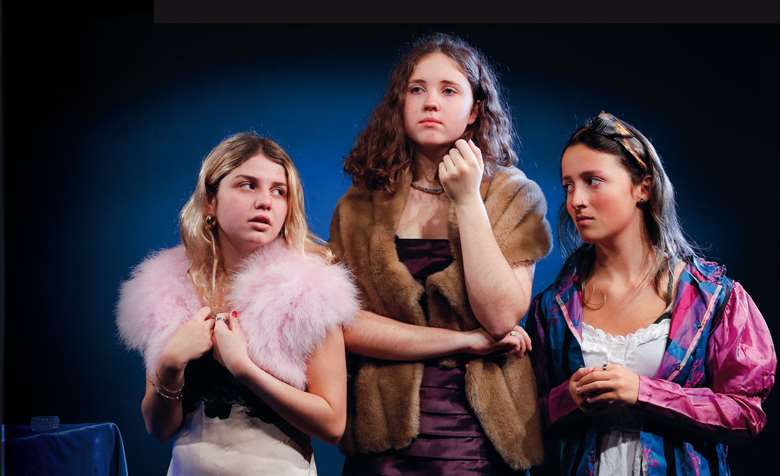Play for Study: The Maids
Chris Whyld
Tuesday, December 1, 2020
Each issue of D&T we bring you a teachers’ guide to a play for study with your students, written by a fellow teacher. This issue, Chris Whyld takes a fresh look at an absurdist option for A Level

STUART THOMAS
One of Edexcel's A Level Drama and Theatre play choices for Component 3 – Theatre Makers in Practice, interpreting one performance text, in the light of one practitioner for a contemporary audience – is Jean Genet's absurdist masterpiece The Maids.
Context and synopsis
The Maids was inspired by the real-life crime committed by sisters Christine and Léa Papin in 1933. Christine and Léa were servants in a bourgeois home in the small town of Mans. The family were unduly harsh with them and, after a scolding from the mother and daughter, the sisters, overcome by an uncontrollable fit of rage, tore out their eyes and then killed them. They further mutilated the corpses and bathed in the blood.
Genet reimagines the Papin sisters’ madness, depravity, and mutual dependency through sisters Solange and Claire who perform role-plays every evening while the wealthy Madame is out of the house. In subversive and often sadomasochistic scenarios, the sisters fantasise about murdering Madame. Claire, the youngest of the two, becomes Madame, while Solange, the eldest and most indignant, plays Claire. Additionally, they have anonymously denounced Madame's lover, Monsieur, as a criminal, and the boundary between reality and fantasy is blurred – we are left feeling unsure what is real and what is not.
History
The first performance of The Maids was at the Théâtre de l’Athénée in Paris in 1947. Directed by Louis Jouvet, it was an opulent affair, intended to be a real curtain-raiser, with Louis XV furniture and costumes designed by Lanvin. This was not at all in the style Genet had envisaged, in fact he was reported to have said, ‘I left the theatre, decided never to see Jouvet again’.
His vision was one of simplicity, paired back, jaded, and seedy to reflect Claire and Solange's outsider, marginal and morally ambiguous characteristics. The original 1947 production versus Genet's preferred design make for thought provoking class discussion when students are in the design phase of their production concept.
Absurdism
The most popular choice by far in terms of practitioner pairing is Antonin Artaud. Both Artaud and Genet were writing, to an extent, in response to the horrors and aftermath of war, specifically a Western European, French response. Both writers preferred the grit and dirt of theatre to the cleanliness and rigidity of French society. Both writers saw theatre as an arena to explore ritual, baseness, human viscera and death. And it has been reported that if not a great influencer, Genet was at the very least a follower of Artaud.
The Artaud-Genet combination also facilitates the overlapping of Theatre of the Absurd, a style often attributed to Genet, and Artaud's Theatre of Cruelty. Both Absurdity and Cruelty can be acknowledged in production concepts as they have similar roots: the notion that life is simultaneously meaningful and meaningless, and that existence is inherently contradictory. A Genet-Artaud blend is also conducive to provoking a strong and complex audience reaction – a biting Absurdist satirical questioning along with an Artaudian punch in the face.
Themes
Thematically speaking there are various avenues to explore. For me, it makes sense to begin with the theme of ritual. The play opens with Solange holding a pair of rubber gloves which she seems to be imagining as a far more expensive high fashion garment – something a lady might wear to the opera.
The stage direction is: SOLANGE has been playing with a pair of rubber gloves and observing her gloved hands, which are alternately spread fanwise and folded in the form of a bouquet.
Inspired by this stage direction, I have rehearsed with students an extended, ritualistic movement sequence which is intended to set the scene for the audience and communicate who these two characters are. To add Artaudian elements, recently a student made a visually impactful short film (think flesh, blood, insects), which was projected while this repeated movement sequence, or ritual, was performed. We underscored it with a disconcerting medley of low hums and buzzes.
Stage design
The play's ‘fantasy versus reality’ theme can be communicated through design. We have looked at how a stage beset with mirrors can be used to distort realty and how reflections themselves have the quality of being simultaneously real and an illusion.
Power within relationships, whether between the sisters or between the sisters and their employer, is an important theme to communicate in The Maids. The heightened use of language the sisters use when in role in contrast to their language when out of role is one way the shifting dynamics can be portrayed.
The Maids is complex, intriguing, and at times frustrating, but it certainly facilitates in-depth discussion, and in terms of interpreting it for a contemporary audience, the possibilities are ample.

